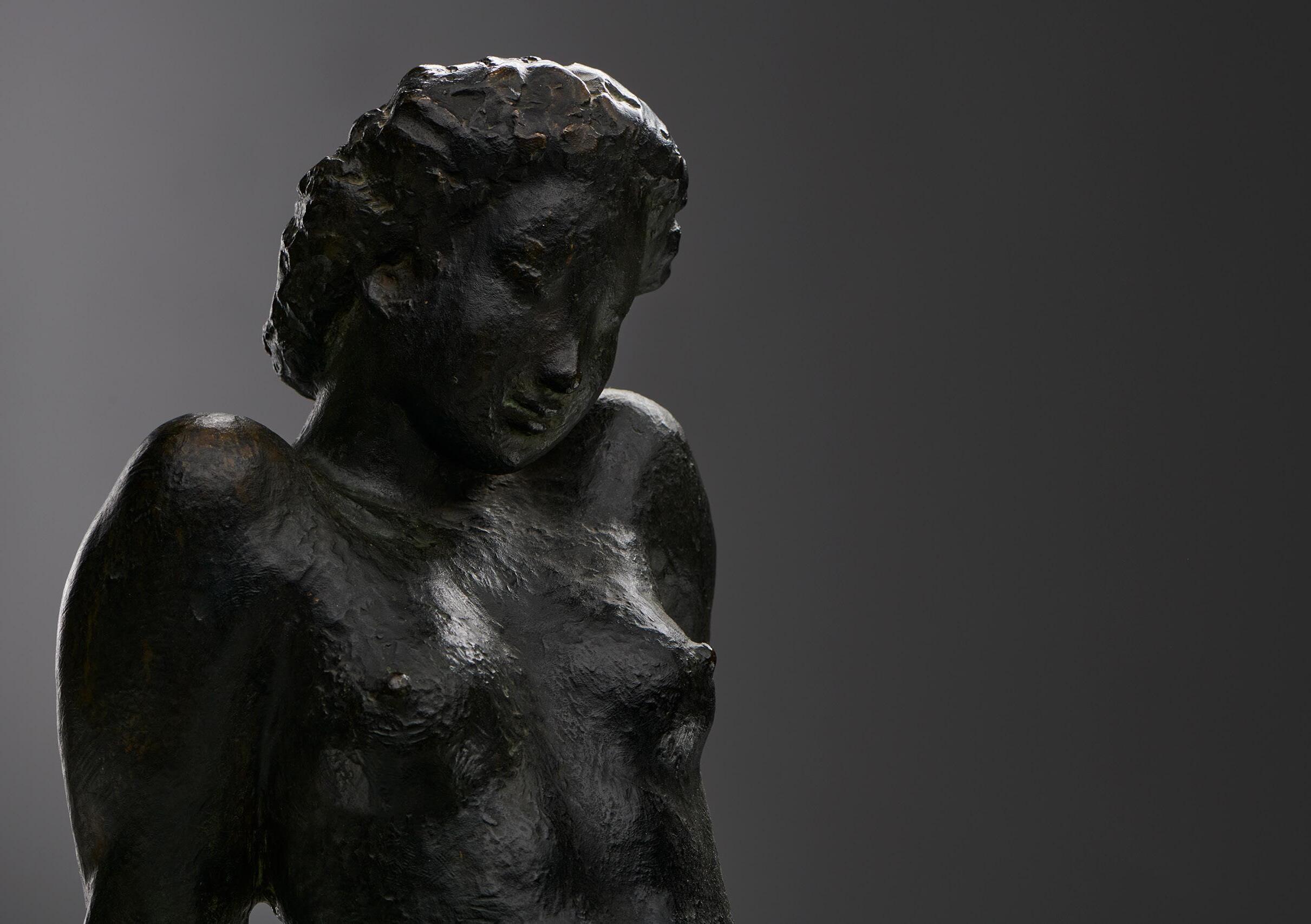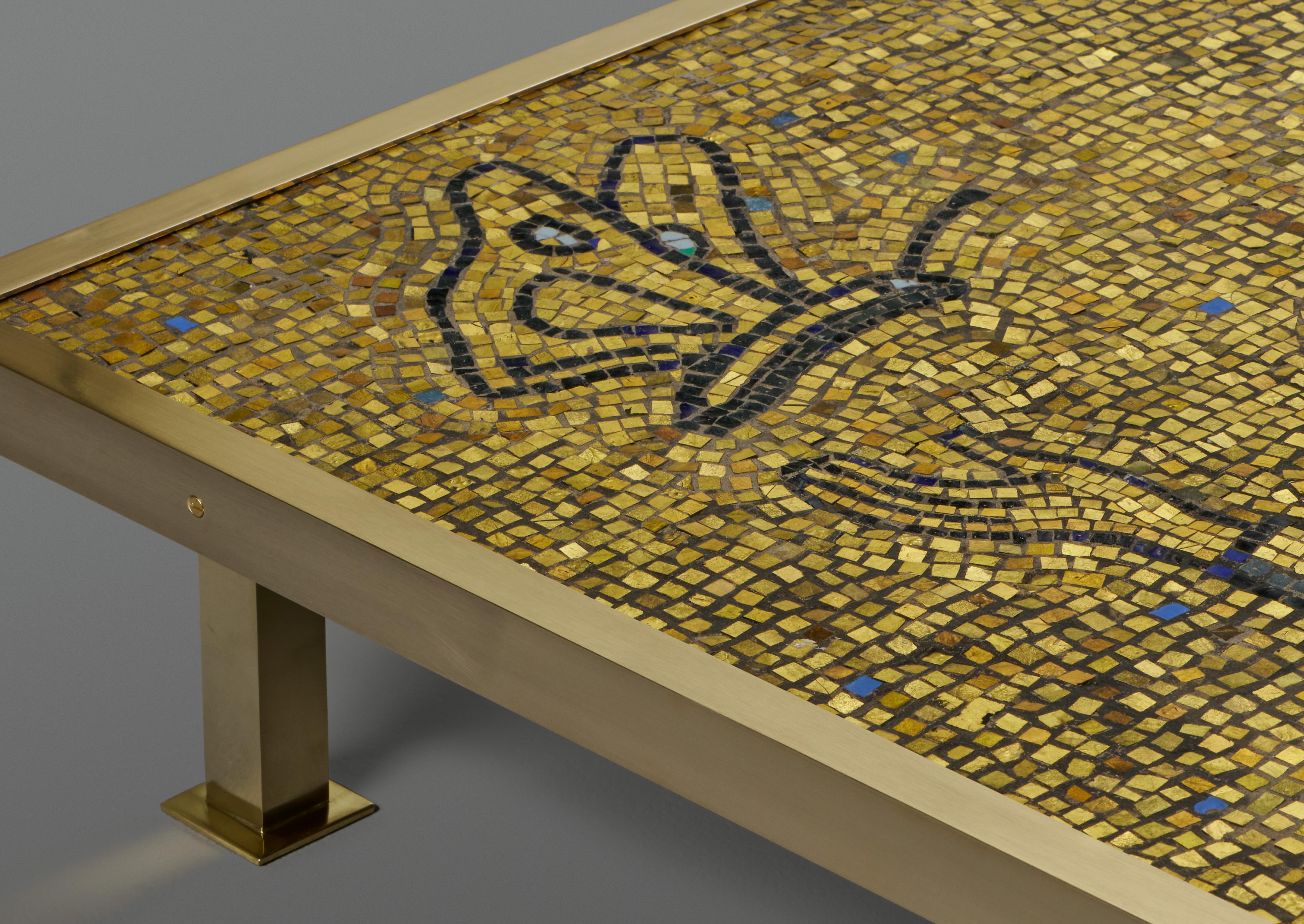



LOOKBOOK
Spring 2024
jacksons.se

HUGO ELMQVIST, ELSA KOCK
Vase
Circa 1900
Patinated bronze with decoration in relief
Signed to the base

HUGO ELMQVIST
Sculpting the Ethereal
Hugo Elmqvist (1862-1930), a Swedish sculptor, carved a distinctive niche with his sculptural works, diverging from the region’s celebrated tradition of functional design to explore realms of symbolic and aesthetic expression. Born amid the picturesque landscapes of Sweden, Elmqvist’s oeuvre was deeply influenced by his surroundings, seamlessly blending naturalistic forms with the emergent currents of Art Nouveau that swept through Europe at the turn of the century.
His educational journey started at the Royal Swedish Academy of Fine Arts, where he matured into a sculptor with a profound understanding of both classical traditions and contemporary movements. Elmqvist’s work is typified by a dynamic interplay of form and emotion, capturing the delicate nuances of the human condition alongside the sublime beauty of the natural world.
His preference for bronze as a medium extended beyond stylistic choice; it was a declaration of his artistic mission. Bronze, with its enduring strength and subtle warmth, enabled Elmqvist to encapsulate the ephemeral beauty of nature and the intricate delicacies of human emotion in a manner that was both monumental and intimate. His sculptures frequently depicted human figures and elements of nature entwined, suggesting a symbiotic relationship wherein each derives strength and exposes vulnerability.
Elmqvist transformed bronze—a material noted for its heft and permanence—into ethereal forms that appear to whisper secrets of the natural world. With his touch, bronze blossomed into delicate leaves, gentle waves, and expressive human forms, each piece bearing witness to his ability to transcend the material’s inherent characteristics.
Vase
Circa 1900
Patinated bronze with decoration in relief
Signed to the base
HUGO ELMQVIST




FLEMMING LASSEN
Sofa Circa 1940
Ash, sheepskin upholstery

WILHELM KÅGE
Vessel with Lid
1951
Glazed stoneware, carved and applied relief
Impressed with manufacturers mark and dated
Produced by Gustavsberg Studio


BERTIL BRISBORG, OLLE ELMGREN
Monumental Wall Lamp
1951
Lacquered tubular steel, engraved glass, brass
Produced by Nordiska Kompaniet
Provenance:
Cinema, “Forellen”, Luleå, Sweden, 1951.








Cinema, “Forellen”, Luleå, Sweden, 1951.


WILHELM KÅGE
Large Bowl 1957
Carved, inscribed and glazed stoneware
Impressed with manufacturers mark and dated
Produced by Gustavsberg Studio

1917 Glazed, carved stoneware
Signed with manufacturers mark and dated
Produced by Gustavsberg Studio
JOSEF EKBERG ‘Sgraffito’ Vase


‘Tulip’ vases, information on next page.


Bathing
crowd, Öresjö; Trollhättan, Sweden, 1958, Stig Olsson, Vänersborgs Museum.
NILS LANDBERG ‘Tulip’ Vases Circa 1950 Hand blown glass Signed with manufacturers mark and numbered Produced by Orrefors Sold individually
 GERHARD HENNING Bronze Sculpture Circa 1920 Patinated bronze
Signed with manufacturers and artist mark
Produced by Lauritz Rasmussen Provenance: Sigrid and Folke Isacsons collection; Art dealer Tore Gerschmans (1913-1992) collection.
GERHARD HENNING Bronze Sculpture Circa 1920 Patinated bronze
Signed with manufacturers and artist mark
Produced by Lauritz Rasmussen Provenance: Sigrid and Folke Isacsons collection; Art dealer Tore Gerschmans (1913-1992) collection.


Frontside
JOHAN AXEL GUSTAF (J.A.G.) ACKE
Painting ‘Study for Östrasalt’
1906
Oil, lined canvas, lacquered wood
Study to the reverse
Signed by the artist
Provenance:
Sigurd von Kock; Rikard Lindström; Villa Akleja, Vaxholm.
J.A.G. ACKE
‘A Study for Östra Salt’, 1906
The Swedish painter J.A.G. Acke, was as a Swedish painter, who was notable invloved in the Arts and Crafts movement in Sweden. The painting ‘Östrasalt’, or as it is actually called, ‘Eistrasalt’, refers to the ancient name for the Baltic Sea. The painting embodies Acke’s spiritual quest and is an apotheosis of the archipelago, as well as a symbolic attitude order to humanity’s over-civilised dealings with mother earth.
The men are painted standing on a rock outside Örno, Stockholm. The three people epitomise painter Rikard Lindström, composer Sigurd von Kock, and Johan Axel Gustaf Acke himself. The painting ‘Östrasalt’ was initially bought by the Gothenburg Art Museum, but was not delivered promptly since the left corner was yet to be completed. Instead of finishing the corner, Acke cut the painting in two parts, and presented each part to the models. He then painted a replica indoors, which he delivered to the museum in Gothenburg.
Many years later, after Acke and Sigurd von Kock’s death, Rickard Lindström reunites the two parts. He joins the picture together, and completed the unfinished corner of the painting. Lindström then also signs his contribution.
¨To successfully paint the sea with its varying lustre and roaring waves, requires a lifetime of training. Ake’s seascapes are more like improvisations, where he wrestles with the paint like a skilled swimmer with the power of the ocean wave. With in the foreground bathing figures, whose skin colour shines like opal against the navy blue bay.¨
Ord och Bild, 1926, words by Klas Fåhræus

Backside

SIMON GATE
Pair of Vases
Circa 1930
Gray tinted blown and moulded glass
Inscribed with manufacturers marks
Produced by Orrefors
Sold individually


BARBRO NILSSON
‘Stjärnflossan, Blå’, Carpet
Circa 1950s
Hand woven knotted pile wool
With woven signature ‘AB MMF / BN’
Produced by Märta-Måås Fjetterström AB



AXEL SALTO
VASE
Circa 1940
Stoneware in Solfatara glaze, with decoration in relief Manufacturers and artists mark to the underside
Provenance:
C.C. Thomsen, Mrs. Esther Thomsen; Thence by Descent.
GUNNAR ASPLUND
Ceiling Lamp
1930

Attributed to Gunnar Asplund
Blown glass, painted metal, steel threads
Height can be adjusted to suit
Provenance: Architect John Elisasson.

Perspective Sketch
of the Stockholm Stadsbiblioteket and Observatorielunden, Gunnar Asplund, 1931, Arkitekturmuseet Stockholm.
GUNNAR ASPLUND
The Senna Lounge Chair
Gunnar Asplund (1885-1940) is held in high esteem in Swedish design history. As an architect and designer, his contributions were central to defining the modernist movement in the Nordics, blending modern design’s simplicity and utility with a unique lyrical quality. His works shaped not just buildings and interiors but the very essence of integrating beauty, functionality, and harmony into everyday spaces.
Asplund’s ‘Senna’ lounge chair, was crafted for the 1925 Paris Exhibition. Emblematic of his innovative vision, it united elegance with comfort in a way that was revolutionary. With its fluid curves and understated elegance, the ‘Senna’ chair exemplifies Asplund’s design ethos: objects should be functional yet also stimulate the senses and uplift the soul. The studio he designed for the exhibition included a desk, two chairs, a bookcase, and the lounge chair. All pieces were created by David Blomberg, a distinguished figure in Stockholm. After sketching several iterations, Asplund finalised the ‘Senna’ chair design, drawing inspiration from Tutankhamun. The studio was highly acclaimed at the exhibition and honoured with the Diplôme d’Honneur by the international jury.
Despite this success, the furniture proved too costly for mass production and was never manufactured beyond the exhibition prototypes, which remained with the Blomberg family. In the 1970s, the armchair was donated to the Nordiska Museet in Stockholm, with the desk and other chairs joining the museum collection in 1987. In 1983, Cassina, a prominent design firm, produced a limited edition of the armchair, then introduced as the ‘Senna’ chair. The name references the title of the studio at the exhibition, ‘Vers la Seine’, alluding to the Seine River, which is ‘Senna’ in Italian.
GUNNAR ASPLUND
‘Senna’ Lounge Chair
Circa 1980
Walnut, decorated leather, cast decoration
Manuafcturers marks to the base
Produced by Cassina



View of Interior for Paris Exhibition 1925, ‘Tack vare våra Vänner!’, Nordiska Museet, 1994, p.116.

EINAR FORSETH
Coffee Table
1921
Glass mosaic, brass frame
Height can be adjusted to suit
Produced by Puhl & Wagner Gottfried Heinersdorff
Provenance: August Wagner Archive; Florian Wagner; Private Collection, London, acquired from the above, 1982; Acquired from the above, 2003;
Thence by Descent.
History:
A study for part of the monumental mosaic that was created for the Golden Hall in Stockholm from 1921 to 1923. The work would become known as Swedish artist, Carl Einar Forseths greatest work. Forseth drew inspiration for the Byzantine style of the scheme during his time spent in Instanbul.




Stadshuset, Rägnar Östberg, 1923.
Stockholm

Sold individually
BIRGER KAIPIAINEN Platter Circa 1970
Glazed stonware, iridescent glaze, applied beads in motif
Engraved with manufacturers mark
Produced by Arabia


HANS J. WEGNER
‘Papa Bear’ Arm Chair
Circa 1950
Oak arms, nails and legs, wool upholstery
Manuafcturers marks to the base
Produced by AP Stolen
Available in several colors


MÄRTA
MÅÅS FJETTERSTRÖM
Tapestry ‘Vildhästen’ (The Wild Horse)
After 1950
Handwoven wool and linen, on linen warp
Signed with manufacturers marks
Produced by Märta Måås-Fjetterström AB

Laminated beech, original wool upholstery with leather buttons
Signed with manufacturers marks and dated Produced by Firma Karl Mathsson
BRUNO MATHSSON
‘Berlin’ Daybed 1972
 Bruno Mathsson, 1951, Gullers, K.W., Nordiska Museet.
Bruno Mathsson, 1951, Gullers, K.W., Nordiska Museet.



Produced by Orrefors
SIMON GATE ‘Graal’ Vase 1919
Hand blown glass in the Graal tecnhnique
Blown by Knut Bergqvist, engraved by Heinrich Wollman
Inscribed with manufacturers marks and numbered

TAPIO WIRKKALA
‘Leaf’ Dishes Circa 1950
Walnut, maple. beech, stained ash Inscribed with artist marks
Produced by Soinne et Kni Sold individually

TAPIO WIRKKALA
From Forest to Form
Tapio Wirkkala (1915-1985) embodies the deep connection between nature and Finnish design philosophy. As an artist and designer, his work traversed a wide spectrum of materials and forms, encompassing everything from precious metals to paper. Nonetheless, it was his profound bond with nature that distinctly characterised his aesthetic, yielding designs that were at once innovative and innately organic.
Wirkkala’s engagement with nature was at the core of his design philosophy. He regarded the forests, lakes, and light of Finland not as mere backdrops but as essential components to be interlaced with the fabric of his creations. This deep bond is apparent in his scrupulous attention to natural forms, from the complex patterns of a leaf to the fluid motion of water. His designs represent a conversation between material and nature, with each piece embodying a concentrated expression of nature’s splendour.
His fascination with the natural world is poignantly manifested in his iconic wooden leaf dishes. These dishes, shaped with meticulous precision, echo the fine veins and unique asymmetry of leaves. Choosing wood pays tribute to Finnish forests and imparts a tangible warmth, allowing nature’s essence to be experienced in every contour and surface.
Wirkkala’s influence on glass design is equally celebrated. His work in this domain demonstrates remarkable adaptability, spanning from functional items to pure artistry. His glass pieces often replicate elements of nature — water, ice, and light — enshrining their transient beauty in a medium both delicate and resilient. His skill in shaping glass to echo the fluidity and liveliness of the natural world established him as an adept of the craft.
 Tapio Wirkkala, photographer Maaria Wirkkala, Courtesy of Tapio Wirkkala Rut Bryk Foundation.
Tapio Wirkkala, photographer Maaria Wirkkala, Courtesy of Tapio Wirkkala Rut Bryk Foundation.

TAPIO WIRKKALA
Vase 1983
Hand blown glass in the Incalmo technique
Inscribed with manufacturers marks and dated
Produced by Venini




Sibyllegatan 53
114 43 Stockholm Gallery
Showroom
Frihamnsgatan 50
Magasin 6, 4th Floor
115 56 Stockholm
Open by Appointment
www.jacksons.se
info@jacksons.se

www.jacksons.se




























 GERHARD HENNING Bronze Sculpture Circa 1920 Patinated bronze
Signed with manufacturers and artist mark
Produced by Lauritz Rasmussen Provenance: Sigrid and Folke Isacsons collection; Art dealer Tore Gerschmans (1913-1992) collection.
GERHARD HENNING Bronze Sculpture Circa 1920 Patinated bronze
Signed with manufacturers and artist mark
Produced by Lauritz Rasmussen Provenance: Sigrid and Folke Isacsons collection; Art dealer Tore Gerschmans (1913-1992) collection.


























 Bruno Mathsson, 1951, Gullers, K.W., Nordiska Museet.
Bruno Mathsson, 1951, Gullers, K.W., Nordiska Museet.





 Tapio Wirkkala, photographer Maaria Wirkkala, Courtesy of Tapio Wirkkala Rut Bryk Foundation.
Tapio Wirkkala, photographer Maaria Wirkkala, Courtesy of Tapio Wirkkala Rut Bryk Foundation.





